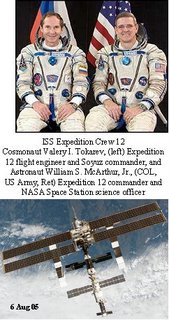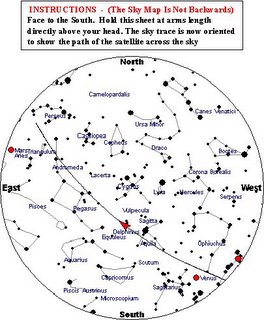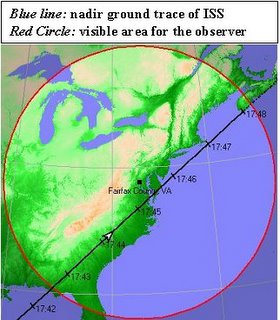9:34 AM
Keep your eyes on the skies
Mister Nizz
Visual Pass of the ISS to occur shortly
Date: Wednesday, 02 November 2005
Satellite: ISS
Observer's Location: Fairfax County, VA ( 38.80°N, 77.20°W)
Local Time: Eastern Standard Time (GMT - 5:00)
Orbit: 345 x 347 km, 51.6° (Epoch 31 Oct)
Sun elevation at time of maximum pass elevation: -8.0°
Sunset: 1708 hrs (5:08 P.M.)
Velocity of ISS: 27,674 kmph (17,196 mph)
Period (1 Rev around Earth): 92 min
Local Weather Prediction: Clear

MOTE: this is of interest for people on the EAST COAST OF THE UNITED STATES.
(from NASA press release)
The International Space Station will make a visible pass over the Pentagon/Northern VA area on Wednesday evening, 2 Nov 2005, just after sunset. See the attached PowerPoint slide for viewing times and a sky map of the pass. Please read the instructions on the slide to properly orient the sky map. Viewing times are accurate for a radius of about 50 miles.
The ISS passes within view of your area occur frequently but most passes are in the middle of the night when the ISS is in the Earth's shadow or during the day when the sky is too bright. Visible passes occur when the ground observer is in darkness yet the satellite is illuminated by the sun. This occurs if the satellite passes within view just before sunrise or just after sunset. Most visible passes are low on the horizon and, therefore, difficult to see. Generally, I only send out viewing information for high elevation passes.
When a visible pass occurs, the ISS can be seen with the naked eye because it is in low earth orbit and it reflects a lot of sunlight because it is so large. Weight: 404,069 pounds. Habitable Volume: 15,000 cubic feet
Dimensions: Width Across Solar Arrays: 240 feet
Length: 146 feet from Destiny Lab to Zvezda; (171 feet with a Progress docked)
Height: 90 feet
NASA astronaut William McArthur, 54, a retired U.S. Army colonel, commands Expedition 12. Valery Tokarev (pron: Vuh-lair'-ee Toe'-kuh-reff), 52, a colonel in the Russian Air Force serves as Flight Engineer and Soyuz commander.
ISS Commander McArthur is a veteran of three spaceflights, including two previous visits to space stations – one to the Russian Mir space station and one to the International Space Station. McArthur conducted three spacewalks during his previous mission to the International Space Station on the STS-92 mission in 2000 that set the stage for the arrival of the first expedition crew. This will be McArthur’s first long-duration mission aboard the complex. He will be responsible for the overall success of the mission and will serve as the NASA science officer, monitoring and operating a suite of U.S. science experiments. He is expected to conduct spacewalks during the flight in both U.S. and Russian Orlan suits.
Flight Engineer Valery Tokarev (FE-1), representing Roscosmos, flew aboard the space shuttle Discovery on STS-96, a joint mission to the space station in 1999. This will be his first long-duration spaceflight. Tokarev will serve as the Soyuz spacecraft commander, responsible for launch, rendezvous, docking, undocking and landing operations. He will also oversee rendezvous and dockings of Russian cargo spacecraft and the suite of Russian experiments onboard the station. He will conduct spacewalks during the flight in both U.S. and Russian Orlan suits.
McArthur and Tokarev are expected to spend about six months aboard the ISS. After the Columbia accident on Feb. 1, 2003, the ISS Program and the international partners determined that the station would be occupied by only two crewmembers until the resumption of shuttle flights because of limitations on consumables.

